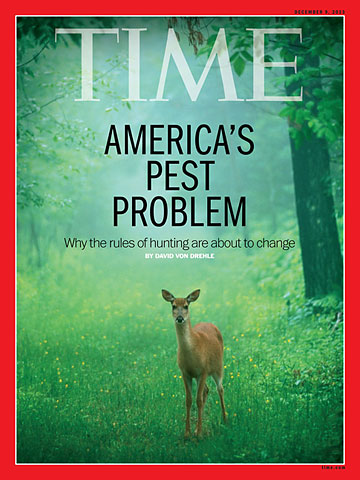
(7 of 7)
In Rock Island, state officials counted deer by helicopter last December and concluded that the population was too high for an urban area. Even so, alderwoman Kate Hotle was skeptical that hunting was the right response. "I do think we have more deer in our city than we did when I grew up here," she said in an interview. "There are more in the urban area of the city. I see deer now in my neighborhood, whereas I never used to. But I don't feel comfortable with us having hunting in our city."
Like many other jurisdictions across the country coming to grips with their fecund fauna, Durham and Rock Island have taken every precaution. They favor bow hunters rather than rifle hunters within city limits: stray arrows aren't a threat to pierce the siding of a house and kill a napping child, as a bullet might conceivably do. The cities restrict bow hunters to shooting from elevated blinds or into ravines, so that the arrow's trajectory is downward. Hunting is limited to golf courses, parks and private land. Still, Hotle remains unconvinced. "There's only a certain number of spaces that are, in my mind, safe enough" for hunting, she told TIME. "It seems an inefficient way to do it."
She might feel better if she paid a visit to Hidden Valley Lake, Ind., near Cincinnati. The little tree-sheltered community found itself overrun with white-tailed deer a few years ago. A helicopter census of the tick-bearing traffic hazards led scientists to estimate a population of more than 50 deer per sq km, at least seven times the optimal number. The deer had chewed through the understory of the Hidden Valley woodlands, devastating habitat for other wildlife, and their feces were raising bacteria levels in the town lake. Meanwhile, road crews were busy clearing deer carcasses from local roadways. Authorities weighed expensive alternatives like traps and contraceptives before choosing to authorize an urban hunt in 2010.
Two years later, after about 300 deer had been killed by skilled archers--permits were issued only to hunters who had passed a test--the deer population remained slightly higher than the ideal for biodiversity. In other words, Hidden Valley still had plenty of deer. But the number of animals killed in traffic accidents fell significantly, while area food banks were well stocked with donated venison. A sort of balance had been restored, in which there is room not just for hungry deer and their human neighbors but also for the plant and animal species that the deer were driving out.
This is nature's way: an equilibrium of prey and predator, life and death. There is no getting around the fact that humans now dominate the environment. We were wrong to disrupt the balance by killing too often during the heedless years of the 19th and early 20th centuries. Now it is wise to correct the more recent mistake of killing too rarely.
--With reporting by Miles Ulmer Graham, Caroline Farrand Kelley and Nicole Greenstein/Washington and Nate Rawlings/New York
